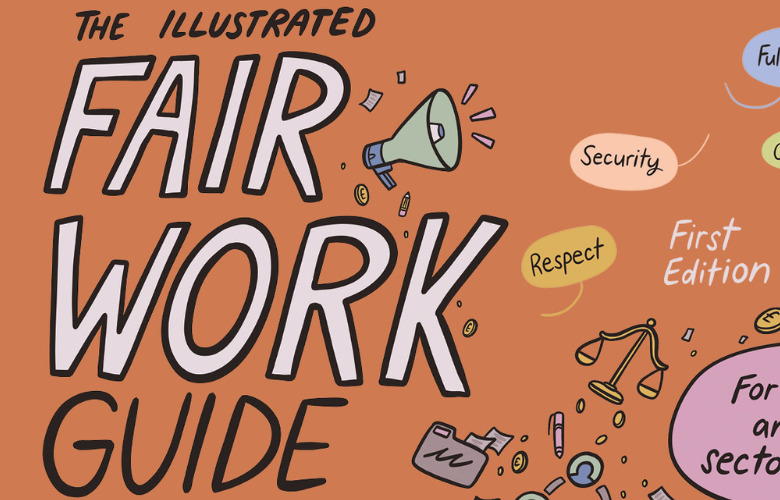
In case there are any lingering questions of how to practise Fair Work in the creative industries in Scotland there is now a step-by-step guide, and it has pictures!The Illustrated Fair Work Guide provides the absolute basics of Fair Work with practical examples of how to put them into practice in the work environment. Introducing each of the Scottish Government’s Fair Work Dimensions – Effective Voice, Opportunity, Fulfilment, Respect and Security – with pictures guiding you along the way. The Illustrated Fair Work Guide has 144 pages (including cover page) and also dedicates a chapter to Fair Work with Freelancers, as well as contributes resources and support for those within the industry.
With the Scottish Government wanting to be the best place to live by ambitiously aiming for being a world-leading Fair Work nation by 2025, employers are going to need to make a few changes to make this dream a reality. The Illustrated Fair Work Guide has all the basics to make this happen:
This illustrated guide dives head first stating that the basic changes employers will need to make are to actually pay the living wage. What a shocker, who saw that coming? The Scottish government take it a step further and place criteria including making no inappropriate use of zero hour contracts and offer flexible working hours from day one of employment.
The numbers that the guide offers are astounding. It clearly calls out employers for issues within the industry such as not being paid on time. Most of these issues that are being called out are done by freelancers. This comes as no surprise when freelancers make up roughly two-thirds of the entertainment industry. Both formal and informal freelancer networks have sprung up to meet these challenges, and it seems the Scottish Government has taken notice.
“Only 38% of freelancers said they were always paid on time when working in the cultural sector.”
If you’re reading along in the Illustrated Fair Work Guide and are still confused on what can be done, they lay all the cards on the table on pages 108-109 in Chapter 7. Transparency, contracts, clarity, inclusion of freelancers, protection, reimbursement, training, and connection are the way to go.
For those who are freelance in the industry, you will find a list of resources and support starting on page 132, Chapter 9 of the Illustrated Fair Work Guide.
While I could still go on and tell you all the great things this guide offers I also am aware that most people in the creative sector won’t bother to download it, let alone read it. If you are a fan of 2D style comics, it will be an easier read. The illustrated part helps break the entire guide into sections while still providing people with the facts that are necessary for all of this to be relevant. Because it really is time to get real. The entertainment and arts industry has been promising for years that things will get better for freelancers (its most reliable source of workers). Many thought this change would occur after 2020 once everything toxic about the industry became very public. Yet it still grasps at everything it can hold onto, including holding out on us.


Janine has always been a part of music and performing. The first show that inspired her to go into theatre was the Velveteen Rabbit which she saw as a child, and Drew works to keep that magic alive in her work. When Drew was accepted into an internship program for audio engineering at a recording studio, she jumped at the opportunity. That was at the start of 2020, and so much has happened since then, both in her career and in the world. Since then, Drew has taken several opportunities to work at recording studios, concerts, festivals, and even large theatres while spending some time on tour. Drew's favorite by far though, has been the chance to work on Broadways and West End shows, as this was a dream come true. Drew is honoured to get to share these experiences from being inside the entertainment industry.
Read Full Profile© 2021 TheatreArtLife. All rights reserved.

Thank you so much for reading, but you have now reached your free article limit for this month.
Our contributors are currently writing more articles for you to enjoy.
To keep reading, all you have to do is become a subscriber and then you can read unlimited articles anytime.
Your investment will help us continue to ignite connections across the globe in live entertainment and build this community for industry professionals.